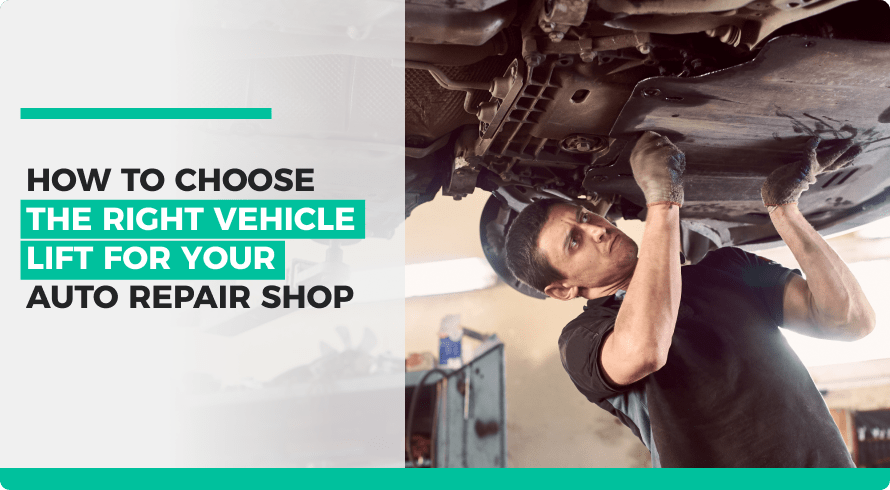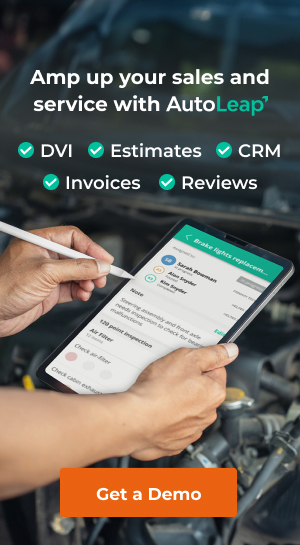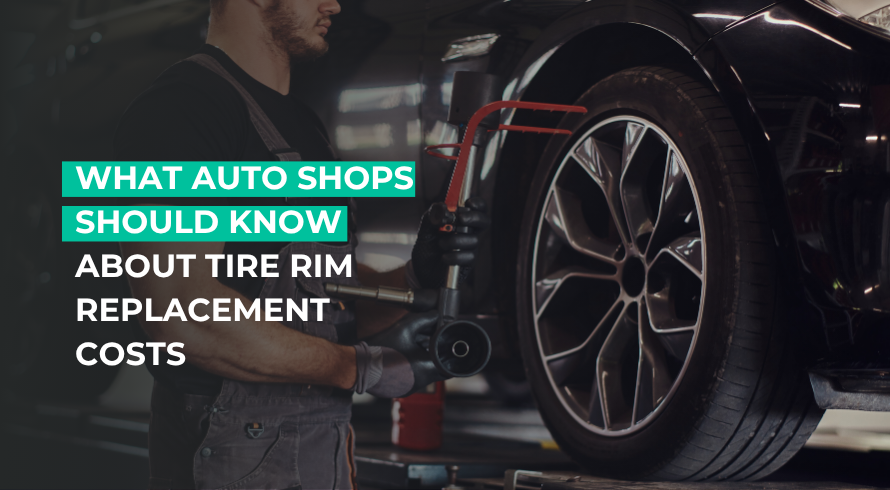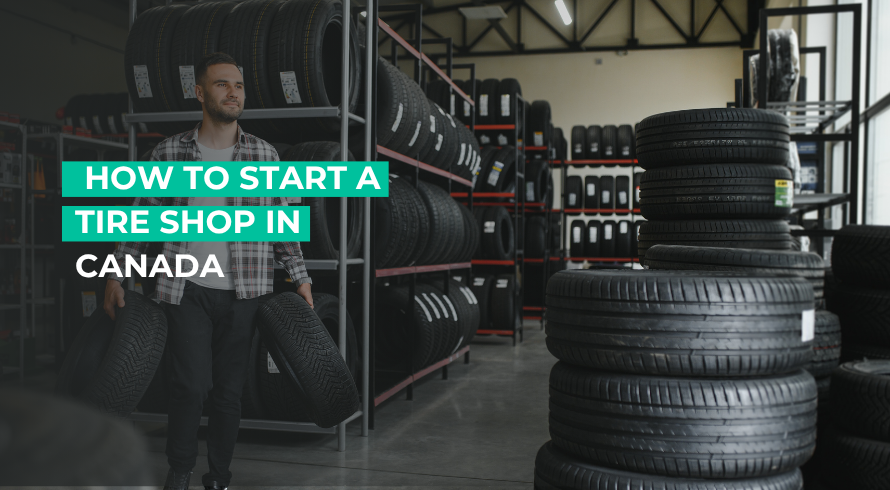Car lifts are indispensable tools for auto repair shops. They offer the ability to efficiently work on vehicles of varying sizes and types. But, this depends on your shop’s needs, space constraints, and the types of vehicles you service. Let’s get into how to choose a car lift and the different types of vehicle lifts so you can make an informed decision.
Understand Your Auto Shop's Needs
Schedule a free demo today!

Boost your shop sales

Simplify shop management

Empower your technicians
Before diving into the specifics of each automotive lift type, assess your auto shop’s requirements. Consider the following.
Vehicle Size and Weight
Start by evaluating the types of vehicles your shop primarily services. Do you work with cars, trucks, SUVs, or specialty vehicles like RVs or motorcycles? Consider their weight and size to determine the appropriate lift capacity. Think about the heaviest vehicle your shop will service.
This information will help you choose an automotive lift with an appropriate weight capacity. If your shop frequently works on heavier vehicles weighing over 10,000 pounds, you will need a lift with a higher capacity. A four-post lift with a capacity of 40,000 pounds might make sense for your auto shop.
Services Offered
Consider the range of services your shop provides. These can include general repairs, bodywork, tire services, and more. Ensure the lift you choose is compatible with the tasks your technicians perform regularly.
Take the example of an auto shop that offers comprehensive bodywork and restoration services. They can invest in a lift with adjustable height settings. This will facilitate easy access to undercarriage work and detailing.
Space & Height Constraints
Evaluate your shop’s floor space and ceiling height. Different lifts have varying space requirements. And you need one that fits comfortably in your shop for smooth operations.
Measure the available floor space in your shop where the lift will be installed. Consider factors like the layout of your shop, existing equipment, and traffic flow. This will help you figure out the optimal location for the lift.
Ideal floor space will depend on several factors related to your shop. But North American Auto Equipment recommends leaving at least 12 feet from your posts to the back wall. That recommendation is specific to symmetrical lifts, while they recommend a minimum of 9 feet for asymmetrical lifts.
The lift you choose must also fit within your shop’s dimensions. It should not obstruct other operations. For shops with limited ceiling height, a low-profile scissor lift or a portable lift may be ideal. This will maximize vertical space utilization.
Your preferred ceiling height will largely depend on the lift you need. Ensure you review the technical specifications of your lift and its overall height before making any investment.
With that said, benchmarks are still helpful. Landmark Tools recommends at least 12 feet of clearance for most two-post lifts but mentions you’ll likely need a higher ceiling for certain four-post lifts.
Remember to also factor in the ground clearance your techs need! Working on vehicles all day in your shop shouldn’t be an uncomfortable experience for them. Crouched positions and poor posture can affect your team and impact productivity.
Future-Proofing
Consider future growth and expansion when selecting a lift. You can choose one with a higher weight capacity than currently required. It will be compatible with larger vehicles or increased workloads in the future.
You can even consider investing in a modular lift system. This will allow for capacity upgrades as the business expands. This will provide long-term flexibility and scalability.
Real-Life Considerations for Car Lifts
Automatic Locking Systems
Look for lifts equipped with automatic locking systems that engage when the lift reaches a specific height. This will keep the car lift stable and will prevent accidents.
Overload Protection
Consider lifts with overload protection features. This will prevent the lift from operating beyond its capacity. It will automatically stop lifting the vehicle when weight is exceeded.
Again, this keeps the safety of your auto mechanics in check. It reduced the risk of equipment damage and personnel injuries.
Ease of Operation
Choose a lift that is easy for technicians to operate. You need one with intuitive controls and smooth lifting mechanisms. This will streamline workflow and reduce downtime.
An auto shop can invest in a hydraulic lift with user-friendly controls and adjustable settings. It allows technicians to lift vehicles efficiently without extensive training.
Maintenance Requirements
Select a lift from a trusted brand known for durable construction. Look for ones that offer comprehensive maintenance packages. This ensures the lift operates smoothly for years to come.
Cost Analysis
Compare the initial cost of the lift with its long-term value. Factor in durability, performance, and maintenance costs. Also, consider upfront costs and potential savings in repair time. Choose a lift that offers a balance between affordability and quality.
Return on Investment
Consider how the lift contributes to productivity, efficiency, and customer satisfaction. Calculate the potential return on investment based on increased workflow and reduced downtime.
Manufacturer Warranty
Look for lifts that come with a manufacturer’s warranty covering defects and malfunctions. Understand the warranty terms, including duration and coverage.
Some auto shops invest in a lift with a comprehensive five-year warranty that includes parts and labor. This provides peace of mind and cost savings in case of unexpected issues.
Customer Support
Choose lifts from manufacturers known for excellent customer support. This includes technical assistance, troubleshooting, and timely response to service requests.
Some auto shops prioritize lifts from a manufacturer with a dedicated support team available 24/7. This means there is minimal downtime and prompt resolution of any lift-related issues.
6 Types of Car Lifts

1. Two-Post Lifts
Two-post lifts are versatile and suitable for shops working on sedans, SUVs, and smaller trucks. They come in 4 designs.
Symmetrical Two-Post Lifts have evenly spaced columns and arms. This makes them versatile for various vehicle types. Where as, asymmetrical two-post lifts feature unevenly spaced columns for easier access to vehicle interiors.
Versymmetric® Two-Post Lifts combine symmetrical and asymmetrical features for versatile lifting capabilities.
Overhead Two-Post Lifts have hydraulic components positioned above the vehicle for greater clearance.
You can choose the two-post lift best suited to your shop’s layout and vehicle types. But if you are tight on space for your new equipment, this can easily fit in. It is a reliable and affordable option.

Lifting Capacity
Estimates for a two-post lift’s capacity can vary widely. But Tire Business states that the lift capacity can range from 7,000 pounds to 30,000 pounds.
For example, an auto shop specializing in mid-sized sedans can get a symmetrical two-post lift with a 10,000-pound capacity. This will provide efficient service without compromising space.
2. Four-Post Lifts
Four-Post Lifts are ideal for larger vehicles and provide stable support. The four-post car lifts come in open-front and closed-front designs. This will cater to different accessibility and repair needs.
An open-front lift doesn’t feature a traditional front crossbar, while a closed-front lift does feature a bar in the front. Your shop’s decision on which format works best comes down to your tech’s preferences and factors like vehicle types, the level of accessibility you need, and the repairs you will cover.
Lifting Capacity:
JMC Equipment states that four-post lifts can range from “6,000 pounds to even 40,000-pound lifting capacity.”
An auto shop handling commercial vehicles can invest in a closed-front 4 post lift with a 30,000-pound capacity. This will ensure safety and convenience during brake and tire work and heavy-duty repairs.
3. Scissor Car Lifts
Handling Specialty describes a scissor car lift as a lift that “consists of two platforms parallel to one another. They are connected by legs in a pantograph or scissor pattern to provide lift. As they constrict, they raise the platform and lower the platform as they expand.
These scissor lifts are space-saving and suitable for shops with limited floor space. They offer various rise variations to accommodate different vehicle access requirements.
Lifting Capacity:
Capacity ranges can vary widely depending on the vehicle types you’re supporting. But some scissor car lifts have lifting power of up to 7,000 pounds, as BendPak can manage with its SP-7XE Full-Rise model.
An auto shop that focuses on sports cars and performance vehicles can choose a low-profile scissor lift with a 6,000-pound capacity. This optimizes space without compromising on performance.
4. Portable Car Lifts
These are ideal for shops requiring mobility and flexibility. Portable lifts offer adjustable designs without compromising safety or stability.
Lifting capacity
Portable lifts can handle up to 7,000 pounds, as outlined in specs like BendPak’s MaxJax M7K Portable Car Lift.
If an auto shop specializes in on-site repairs, it can invest in a portable car lift with a 7,000-pound capacity. This allows technicians to work efficiently at various locations.
5. In-Ground Car Lifts
Installed on the floor of the service bay, in-ground lifts save space and provide convenient activation settings. But, they may require a higher budget.
Lifting capacity
An in-ground car lift can lift up to 10,000 pounds, as displayed by options like the Rotary Two-Post Lift by Standard Industrial and Automotive Equipment.
If an auto shop installs an in-ground car lift with a 10,000-pound capacity it can maximize space utilization and workflow efficiency.
6. Parking Lifts
Featuring a two-way drive-on deck, parking lifts allow for stacking vehicles. This makes them suitable for shops with limited parking space or specialized lift needs.
Parking lifts help accommodate additional vehicles. It optimizes their lot space and provides convenience for customers.
But for most general maintenance and repair businesses, this lift doesn’t make sense compared to other options.
Wrapping Up
Choosing the right automotive lift for your auto repair shop is strategic. It impacts workflow, safety, and long-term efficiency. By evaluating your shop’s needs, you can make an informed choice. Consider space constraints, anticipate future growth, and prioritize features like weight capacity, safety mechanisms, and maintenance requirements.
Remember, the ideal lift varies depending on your specific circumstances, so take your time to research and select the one that best aligns with your goals and operational requirements.
Frequently Asked Questions
1) Which vehicle lift is best?
The best vehicle lift depends on your shop’s specific needs and requirements. But one quality option is the Triumph NSS8-8.
2) How thick should concrete be for a car lift?
Concrete for a car lift should ideally be at least 4 inches thick for proper stability and weight-bearing capacity. It should ideally have 6 inches.
3) How tall should a garage be for a car lift?
A garage should have a minimum ceiling height of around 12 feet to accommodate a car lift comfortably. It also helps knowing the kind of vehicles you commonly get in your area. If you normally work on smaller cars, then 11-12 feet is an ideal garage height.







